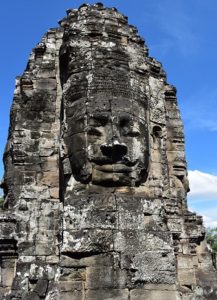We are in the year 1100 AD. The word rocket isn’t even thought of in the English language. Much later in 1232 AD, once the Angkors were nearly 90 years old, the Chinese during the battle of Kai-Keng, would be using arrows of flying fire, the rockets, against Mongols – (Chinese again!). Caltech and MIT are not even remotely in any dream. People to dream of IITs of India will be born a mere 900 years later. My own Alma Mater, the Thomason College of Civil Engineering is waiting to take birth 700 years from now. That much for the knowledge of Engineering & Architecture whilst Angkor is taking shape; the largest undertaking by human being ever before. Or after that.
—–x—-x—x—-
That was the state then and Cambodia was just about 1.4 million of populace. Everything including huge labour force , large quantities of materials of requisite quality, tools, elephants, camping arrangements, logistics of food, medical arrangements, constant replenishment of everything including labour force, expert planners whose administrative skills would have been tested already, artists of stone, tools makers, transportation, Priest-Architects, Architects and many other entities had all to be planned for procurement by top notch HR managers and Purchase experts. Funds
for such venture would have been yet another almost unsurmountable task. Remember what that shrewd Guru Chanakya had told his King – a King who does not pay his subject well for the labour the latter had put in, the coffers of that king shall always keep depleting.
In the engineering community the world over, it is common knowledge that planning of any large project requires back-breaking efforts for at least two years. Planning for everything from people to materials to logistics to funds; everything. And when you have taken upon yourself the onerous task of the largest anything ever, God alone know the limits, in that case.
While visiting the Temples at Angkor, these and many more such questions were constantly stirring my mind. Especially the thought that someone like myself must have been made the overall Project Director of this awesome venture. Him, without any previous experience since no other work of this magnitude had ever been attempted, anywhere. What an almost insurmountable feat this must have been? Thank Gods I wasn’t born then, I always think; fearing the fear of failure. After All, the last stone had to be hauled up 213 meters without any crane. What! no crane! Not only no crane, no Coles, Hitachi, Grove and no Potain too.
Human beings for labour one could still muster, after all a mighty King had undertaken that venture. But high precision tools in required quantities, highly skilful artists sculptors, priest-architects of supreme wisdom so that nothing goes wrong must have been some of the severest challenges before them.
And what if a few artists make a tiny mistake whilst creating that beautiful A psara? Or this scene of a battle or that carving of stone on a column. Afterall, carving/sculpting must have been carried out once all the basic stone work would have been completed. No scope left for a v
psara? Or this scene of a battle or that carving of stone on a column. Afterall, carving/sculpting must have been carried out once all the basic stone work would have been completed. No scope left for a v eritable ‘typographical error’. Just imagine a man working and another one supervising him and yet another superior supervising him as well – there being just no scope for even the tiniest of error. I tried my best; have taken large number of pictures. But could not find any mistake in sculpting
eritable ‘typographical error’. Just imagine a man working and another one supervising him and yet another superior supervising him as well – there being just no scope for even the tiniest of error. I tried my best; have taken large number of pictures. But could not find any mistake in sculpting
even after magnifying them 200 times over. What flawless workmanship; what absolute symmetry. Just who were they? Non-engineers, non-architects out of no any Caltech, MIT, Oxford or IIT. But what they accomplished is surely beyond the celebrated technologists of today.
Before I sign off, a word about the Lord Buddha faces sculpted on the  faces of outside walls and temples. These are truly huge and one gets absolutely & entirely mesmerised at the expression imparted by the artists to their face. At Ta Prohm,Banteay Kdei and at Angkor Thom each one is different as are all the nearly 60 sculptu
faces of outside walls and temples. These are truly huge and one gets absolutely & entirely mesmerised at the expression imparted by the artists to their face. At Ta Prohm,Banteay Kdei and at Angkor Thom each one is different as are all the nearly 60 sculptu res of Men pulling the Holy Serpent Vasuki at the very entrance of Angkor Thom. They must be true geniuses of their profession, anywhere in the world; then, and now.
res of Men pulling the Holy Serpent Vasuki at the very entrance of Angkor Thom. They must be true geniuses of their profession, anywhere in the world; then, and now.
I believe, there is a lesson for us here; me and all of us. If you plan a project, plan it well. Plan it well and then execute that well. Get the best possible people to execute that well. But, please take care of it well. The result of poor upkeep is in front of all of us. It does not matter who created it.